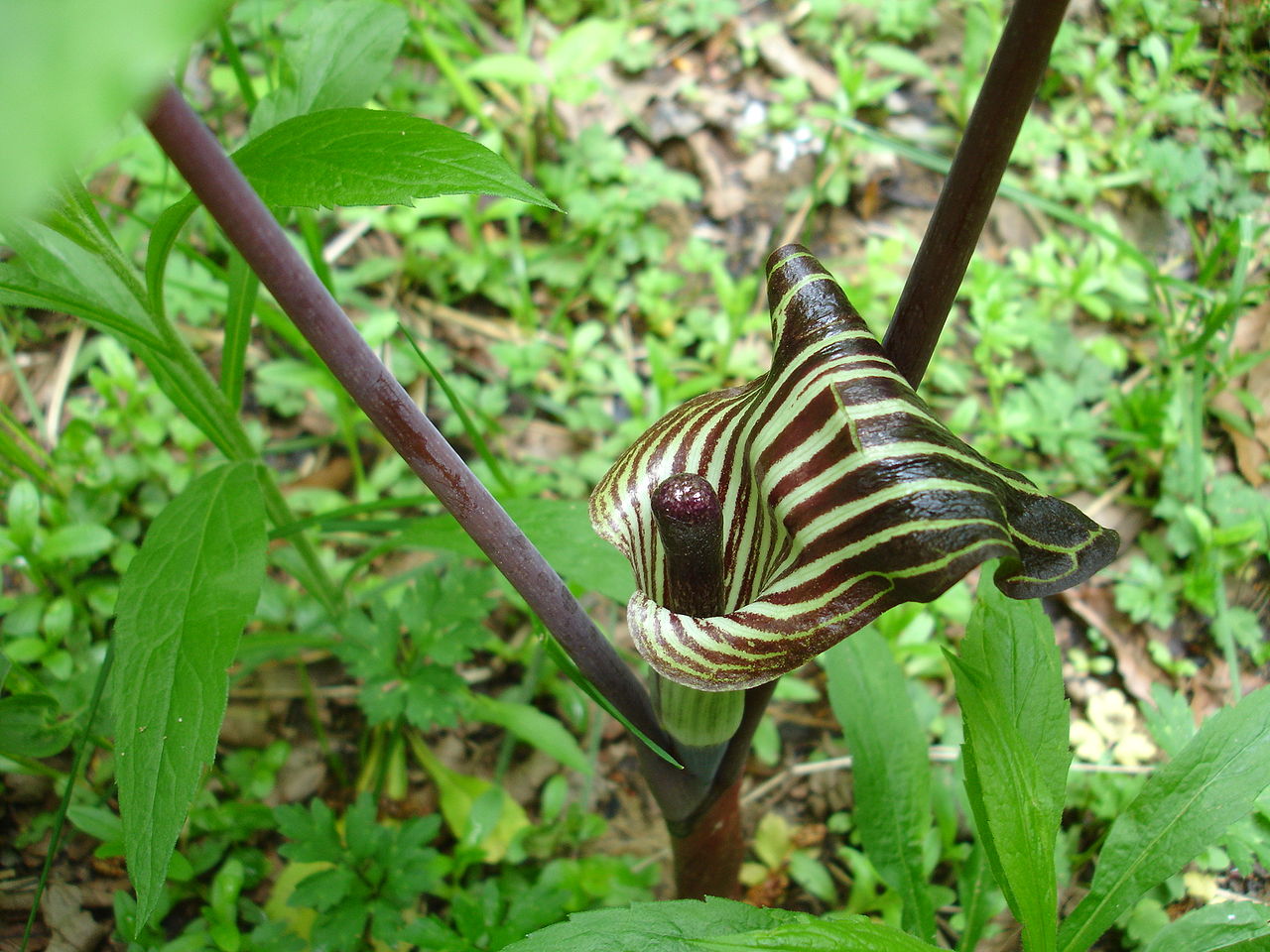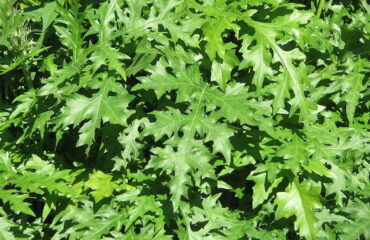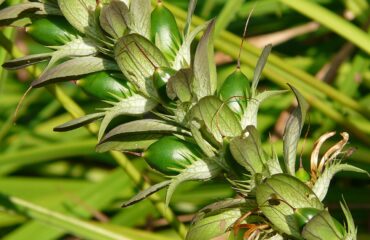Arisaema triphyllum, commonly known as Jack in the Pulpit, is a unique and striking perennial plant native to North America. It is known for its distinctive flower structure, which features a hooded spathe (the “pulpit”) and a central spadix (the “Jack”) that is often covered in tiny flowers. The spathe is typically green with purple or brown stripes, and the plant’s three-parted leaves add to its unusual appearance. Jack-in-the-Pulpit thrives in moist, shaded woodlands and is a favorite among native plant enthusiasts for its intriguing form and adaptability.
Preferred Growing Conditions:
- Soil Type: Prefers rich, moist, well-drained soil with high organic content; thrives in slightly acidic to neutral pH.
- Sunlight: Grows best in partial to full shade; ideal for woodland gardens and shaded areas.
- Temperature: Hardy in USDA zones 4-9; prefers cool to moderate climates and tolerates light frost.
- Water Needs: Moderate to high; requires consistent moisture, especially during the growing season, but needs good drainage to prevent rot.
Arisaema Triphyllum (Jack in the Pulpit) Propagation Methods:
1. Seed Propagation:
Growing Arisaema triphyllum from seeds is a common method for producing new plants, particularly for establishing naturalistic plantings in shaded garden areas.
- Seed Collection and Preparation:
- Collect seeds from mature plants in late summer to early autumn when the berries turn bright red.
- Remove the seeds from the berries and clean off any pulp.
- Seeds can be sown immediately or stored in moist sand or peat moss at a cool temperature over winter for spring planting.
- Sowing Techniques:
- Fill seed trays or small pots with a light, well-draining seed-starting mix.
- Sow the seeds on the surface of the soil and lightly cover with a thin layer of soil or sand.
- Keep the soil consistently moist but not waterlogged.
- Place the trays in a bright, cool location with temperatures around 60-65°F (15-18°C).
- Germination Requirements:
- Seeds typically germinate in 2-3 months, though germination can be erratic.
- Provide consistent moisture and protection from direct sunlight during germination.
- Once seedlings emerge, keep the soil moist and provide bright, indirect light.
- Care for Seedlings:
- When seedlings have developed several true leaves and are sturdy enough to handle, transplant them into individual pots or directly into the garden.
- Choose a location with similar growing conditions to the parent plant, such as a shaded area with rich, moist soil.
2. Division:
Division is an effective method for propagating Arisaema triphyllum, especially for established clumps. This method not only helps propagate new plants but also rejuvenates the parent plant.
- Timing:
- The best time for division is in early spring before new growth begins or in early autumn after the plant has finished its active growing season.
- Method:
- Carefully dig up the entire clump of the plant, taking care not to damage the tubers or roots.
- Shake off excess soil to expose the tubers and the root system.
- Use a sharp knife or garden spade to divide the clump into smaller sections, ensuring each division has at least one healthy tuber and some roots.
- Remove any dead or damaged roots and foliage.
- Replanting:
- Replant the divisions immediately in prepared soil enriched with compost or organic matter.
- Plant at the same depth as the original clump, spacing divisions 12-18 inches apart to allow room for growth.
- Water thoroughly to settle the soil around the roots.
- Care After Division:
- Keep the newly planted divisions well-watered as they establish.
- Mulch around the base to retain soil moisture and regulate temperature.
- Protect from strong winds and direct sunlight during the initial recovery period.
3. Offsets and Bulbils:
Arisaema triphyllum often produces offsets or bulbils at the base of the parent plant. These can be used to propagate new plants.
- Collection and Preparation:
- Collect offsets or bulbils during the dormant season in late autumn or early winter.
- Gently separate them from the parent plant, ensuring they have a portion of the root system attached.
- Planting:
- Plant the offsets or bulbils in small pots filled with a well-draining potting mix or directly in the garden in a suitable location.
- Place them just below the soil surface and water lightly to settle the soil.
- Rooting and Growth:
- Offsets and bulbils will develop roots and shoots over several weeks to months.
- Maintain consistent moisture and provide protection from extreme weather until they establish and begin to grow.
4. Tissue Culture:
Tissue culture is an advanced propagation method used primarily in commercial settings to produce large numbers of uniform plants quickly. This method involves growing plant tissues in a sterile, controlled environment.
- Process:
- Small pieces of plant tissue, typically from the growing tips or meristem, are sterilized and placed in a nutrient-rich, sterile medium.
- Under controlled conditions, the tissue forms a callus, which then differentiates into shoots and roots.
- Once the plantlets are large enough, they are transferred to soil or a suitable growing medium to acclimate to normal growing conditions.
- Advantages:
- Produces a large number of uniform plants quickly.
- Can propagate disease-free plants and maintain rare or desired characteristics.
Care for Newly Propagated Plants:
- Place new plants in a location with partial to full shade and rich, moist, well-draining soil.
- Water regularly to keep the soil consistently moist, especially during dry periods.
- Protect from strong winds and extreme temperature fluctuations.
- Apply a balanced, slow-release fertilizer in spring to encourage robust growth and flowering.
Common Challenges and Solutions:
- Rotting Tubers: Ensure good drainage and avoid waterlogging, especially during the dormant season.
- Pests: Monitor for common pests like slugs and snails, which can damage the foliage. Use appropriate pest control measures such as slug traps or organic deterrents.
- Poor Flowering: Ensure the plant receives adequate moisture and is not exposed to direct sunlight, which can stress the plant.
Additional Tips:
- Mulch around the base of the plants to retain moisture and suppress weeds.
- Allow the foliage to die back naturally after the growing season to replenish the tubers for the next year.
- Avoid disturbing the plant once it is established, as it does not like to be moved frequently.
- Jack-in-the-Pulpit is toxic if ingested, so plant it in areas not accessible to pets or children.
Propagating Arisaema triphyllum can be a rewarding experience, adding an exotic and unique element to your garden. Whether you choose to start from seeds, use division, or propagate offsets and bulbils, with proper care and attention, Jack-in-the-Pulpit will thrive and bring its fascinating blooms and foliage to your shaded garden areas.
Share this article



